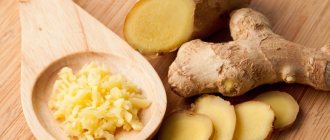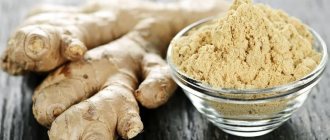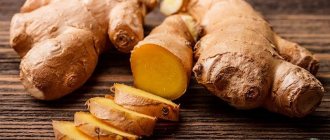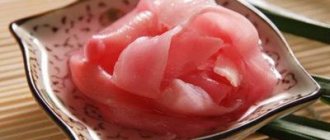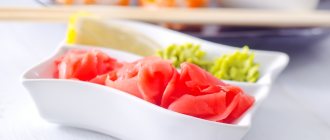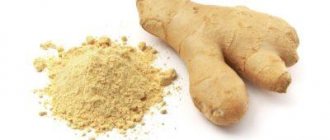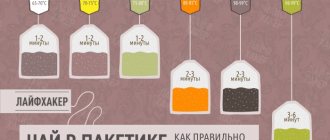Ginger is a well-known storehouse of vitamins and nutrients, known as a means of losing weight, maintaining health, and also a vibrant spice used in cooking. Ginger is rich not only in its spicy, aromatic taste, but also in vitamins such as C, B1, B2, A, calcium, magnesium and phosphorus. Have you ever wondered how to choose the “same” ginger that is healthy and rich in vitamins? After all, your health, beauty and taste of the dish depend on the right choice. In this article we will not only talk about how to choose the “right” ginger, but also how to store it at home.
Useful properties and contraindications
Like all products, ginger root has certain medicinal properties and some contraindications.
First, let's look at how the spine is useful:
- increases blood circulation in the brain, which helps improve memory, concentration, mental activity, relieve emotional stress, headaches caused by creative work;
- stimulates digestion processes, increases appetite, helps get rid of belching and stomach ulcers;
- Ginger root has an expectorant effect. It is recommended for complex treatment of cough, bronchitis, colds, sinusitis, congestive processes in the lungs;
- anti-inflammatory property is used in the fight against sore throat, periodontal disease, and inflammation of the gastrointestinal tract;
- the plant can be used as a natural pain reliever for discomfort in the abdomen, throat, muscles, joints, kidneys, intestines, and abdomen during menstruation;
- the vasodilating beneficial properties of the product are used in the treatment of bronchial asthma and breathing disorders of allergic origin;
- reduces the level of “bad” cholesterol;
- the plant is an excellent antioxidant, removing toxins and poisons from the blood and tissues, which is necessary for the body after ingesting poisonous mushrooms or insect bites;
- decoctions and infusions have an antiemetic effect, it is recommended for early toxicosis, seasickness, motion sickness;
- it is a natural aphrodisiac, stimulates libido in men and women, increases potency and even cures some types of infertility and prostatitis;
- has a mild laxative effect, helps fight constipation and reduces the manifestations of hemorrhoids;
- ginger is a good carminative, quickly relieves flatulence and bloating;
- it thins the blood, restores the elasticity of blood vessels;
- tea and drinks from the plant give strength, invigorate, relieve fatigue, remove signs of stress and mental tension;
- the root removes bile, which is necessary for the human body with jaundice and cholelithiasis;
- the diuretic effect is useful for diseases of the kidneys and bladder;
- with long-term use, the product helps maintain youth and beauty, slows down the aging process;
- due to its ability to speed up metabolism, improve blood circulation in the body and remove accumulated fluid, the root is often used for weight loss as a supplement or even the basis of radical diets;
- When taken for a long time (more than two months), the product helps to activate the human immune system and resist colds and ARVI, so it is recommended for frequently ill people to drink it from late summer to early autumn;
- Taking ginger is a good prevention of cancer, diseases associated with the formation of blood clots (heart attack, stroke), and varicose veins.
And as always, benefit and harm are simply inseparable.
Now it’s time to list the contraindications of the product:
- gallbladder disease (although in some cases ginger helps achieve a good therapeutic effect);
- stones in the gall bladder, since due to the choleretic effect, taking the root can provoke the movement of the stone and cause pain and damage to the bile ducts;
- increased body temperature, since due to the warming effect, such a drink can further aggravate the condition;
- hypertension;
- pregnancy, although in the absence of complications in the first trimester, drinks and teas with ginger perfectly relieve morning sickness.
And, of course, the plant can be harmful to the body in case of overdose; for this it is enough to drink more than two liters of drink or decoction a day. Symptoms of poisoning are: vomiting, diarrhea, nausea, skin rash and other manifestations of allergies.
For men
The previously listed beneficial properties of the plant are also suitable for men, but there are several special points, among them:
- due to its high zinc content, the root is necessary for men with sexual dysfunction, it helps to increase libido, prolong sexual intercourse, and strengthen erections;
- It is also needed for those suffering from chronic inflammatory diseases of the genitourinary system, helping to improve the functioning of these organs, relieve pain, and prevent the most common male disease - prostatitis;
- the product is a strong aphrodisiac, it is suitable for both men and women, so you can drink a delicious drink together at dinner to make the romantic night a success;
- an infusion or ginger tea will please men after a good party, removing a hangover and even partially bad breath better than brine;
- the root is an excellent energy drink, its use will help the stronger sex to always be cheerful, fit, strong, perform both mental and physical work, and quickly recover from difficult workouts.
Contraindications for men are the same: stomach ulcers, allergies to the product, poor blood clotting, hypertension, fever.
For women
It is important to note the unique beneficial properties of the product for women, and for balance, its contraindications.
So, the following features are important for the body of representatives of the fair sex:
- the root is indicated for use in female infertility, as its use helps stabilize the menstrual cycle, accelerate egg maturation, normalize ovulation, improve uterine tone and hormonal levels;
- the product relieves inflammation of the genitourinary system, increases libido even in older women;
- it is often used as a drink for weight loss due to its ability to reduce appetite when consumed before meals, increase metabolism and blood circulation, and relieve inflammation of the gastrointestinal tract;
- during pregnancy, the root perfectly relieves nausea, prevents swelling, vitamin deficiency;
- it is also suitable for women who care about their appearance, the product tightens and rejuvenates the skin, reduces its oiliness, narrows pores, and eliminates inflammation;
- As a mask, the plant eliminates oily hair, dandruff, accelerates hair growth, and gives curls strength and silkiness.
I hope now you won’t have a question about whether the root is good for women. Definitely “yes”, of course, if you have no direct contraindications.

The benefits and harms of pickled ginger
The pickled form has all the same beneficial properties and contraindications as the raw product, but the value of the root is significantly lost during processing.
The pickled pink root is mainly used not for treatment, but for nutrition, or rather, as a spicy addition to rolls, sushi, and now other, even traditional Russian dishes.
Therefore, the nutritional value of this product does not particularly interest us - we do not use it for health, but exclusively as a gastronomic delight. But it is worth noting that a traditional oriental salad contains vitamins, amino acids, acids, essential oils and minerals.
What are the benefits of pickled root:
- slows down the aging process;
- prevents cancer and heart disease;
- improves digestion;
- cleanses the oral cavity, freshens breath and kills germs;
- increases immunity, helps fight colds, bronchitis, sore throat;
- relieves headaches;
- gives strength and energy.
But you should not eat pickled ginger if:
- ulcer;
- diseases of the gallbladder and liver;
- Use with caution during pregnancy and breastfeeding.
And a healthy person, carried away by food, can develop nausea, diarrhea, and vomiting, so you should not overdo it with an unusual dish.

Ginger in sugar
Of course, when dried, some of the nutrients are lost, and when sugar is added, the number of calories sharply increases, so you need to use candied fruits with caution. This is especially true for overweight people and diabetes - they will have to strictly regulate the amount of treats.
In general, candied ginger can be used in different ways:
- as a snack instead of sandwiches and chocolate, a couple of slices will be enough to suppress hunger;
- drink tea with him;
- pour boiling water over a few pieces of candied fruit and get a delicious, sweet tea.
Of course, due to the unusual taste, not everyone will like this addition to the diet, but if you get used to the pungency of the sugar-coated plates, you can give the body strength, warm up, and improve immunity.
During pregnancy
The medicinal properties of ginger root are often used during pregnancy, although you need to be very careful here. An overseas product cannot be considered a panacea for all diseases, since, first of all, it is unusual for our body, which is why it must be used very carefully when carrying a baby.
Necessarily
Before you brew a cup of tea for pregnant women, you need to make sure the safety of the unborn baby, because the slightest mistakes in the mother’s diet can affect it. Before consuming this seasoning, you should consult with your doctor during your pregnancy, as sometimes a tasty drink can do more harm than good. For example, cause allergies in the baby, provoke a miscarriage or premature birth.
If the obstetrician-gynecologist does not see any difficulties, then ginger can be taken in the first trimester to relieve nausea and vomiting, and in the last months as a decongestant. Also, such drinks are very calming, equal in effect to the usual motherwort and valerian, they relieve headaches, dizziness, and fatigue.
Thanks to a large amount of vitamins, ginger fills the body of the mother and her baby with all the necessary nutrients, preventing vitamin deficiency, and also strengthens the woman’s immunity weakened by pregnancy.
But doctors do not advise drinking it in case of late toxicosis, and during periods when a pregnant woman is diagnosed with a threat of miscarriage, those who have had miscarriages in the past should abstain from the product for the entire period of gestation.
Ginger: hot spice
The rhizome is a modified underground shoot.
It is described as similar to the root of the plant, so they are often confused (although both names are used). The rhizome is used fresh or processed. Did you know? A well-known seasoning for sushi and rolls, pickled young ginger (gari) owes its pink color to red perilla (a herbaceous plant). The natural color of the pickled root is yellow-gray.
The spice has a rather specific taste and aroma. This is due to the essential oil contained in the plant (1.5–3%) which includes:
- α- and β-zingiberenes;
- camphene;
- cineole;
- bisabolene;
- borneol;
- citral;
- linalool.
https://www.youtube.com/watch?v=ytpolicyandsafetyru
These components are responsible for the aroma of the rhizome. The burning, pungent taste comes from gingerol.
In addition, the plant contains the following beneficial substances:
- vitamin C - 5 mg;
- vitamin E - 0.3 mg;
- vitamin K - 0.1 mg;
- vitamin B3 - 0.2 mg;
- vitamin B6 - 0.2 mg;
- vitamin B9 - 11 mg;
- vitamin B5 - 0.2 mg;
- omega 3 acids - 34 mg;
- omega 6 - 120 mg;
- calcium - 16 mg;
- iron - 0.6 mg;
- magnesium - 43 mg;
- phosphorus - 34 mg;
- potassium - 415 mg;
- sodium - 13 mg;
- zinc - 0.3 mg;
- copper - 0.2 mg;
- magnesium - 0.2 mg;
- selenium - 0.7 mcg.
Taste qualities
The taste of ginger has a very pronounced bitterness and pungency. It contains notes of black pepper, lemon zest, and dried thyme. It is difficult to compare this taste with any other, since it is too multifaceted and everyone perceives it in their own way.
Important! It is worth noting that ginger enhances the taste of black pepper, giving it unusual freshness.
Fresh ginger has a pleasant, somewhat citrus-like aroma with notes of ground sage leaves. The smell is light, fresh, not sharp, pleasant and lasts a long time thanks to the large number of essential oils.
How to choose ginger
For a product to be as useful as possible, it must be chosen correctly. Which root should you buy in the supermarket to get the best results?
Signs of Fresh Ginger
As a rule, white root is sold in our stores; signs of its quality and freshness are:
- clean, smooth skin without defects or insect damage;
- color golden or light brown;
- absence of wrinkles that indicate drying of the product;
- hard, dense structure.
Where to buy ginger?
There is no problem of complex searching - it can be purchased anywhere and in any quantities, in any form - currently there is a huge abundance of forms in which it is sold: in chocolate, in curry, ground into powder, as an extract for beer , in the form of separate pieces of root and rhizome, in sugar, etc. Each form in which ginger comes in serves a specific purpose. This seasoning is well compatible with other spices. Ginger is always added to high-grade light beer and very often to confectionery products. The most common form of ginger on sale looks like a powder of some gray-yellow color and has a consistency similar to flour. This ginger is usually stored in special sealed packages. Ginger can be bought not only in stores and supermarkets, but also in pharmacies. There it can be found in the form of peeled and dried root, ground into powder (250-500 mg volume), as well as in the form of a tincture or decoction.
How to clean
To begin with, the ginger needs to be cleaned of dust and dirt from the soil using a brush or washcloth, then carefully remove the peel in thin strips, since directly underneath it contains many vitamins and microelements. Well, then all that remains is to chop the root into plates, cubes or grate it according to the recipe.
The product is brewed, infused, steamed, and beaten with other ingredients, depending on what effect they want to achieve. When adding lemon, tea perfectly helps fight colds, ARVI, sore throat, and when adding cucumber, cinnamon, kefir, it is used for weight loss.
Are there varieties with a blue tint?
The main reason why the root of the product in question may turn blue is due to the fact that it is galangal, an exotic plant that is closely related to ginger. It has less pungency and a brighter aroma, reminiscent of perfume.
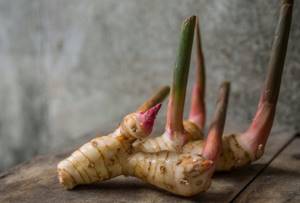
Galangal has a thin, pale pink skin that does not always need to be peeled. It is used fresh as a seasoning for first courses, and the dried spice perfectly complements baked goods.
In addition, there are 2 varieties that are characterized by exactly this coloring of the internal cavity:
- Bubba Baba - a rare Hawaiian variety crossed with Indian ginger, which is evenly colored blue when cut. Moreover, the riper the root crop, the more pronounced the color palette of the internal cavity will be.
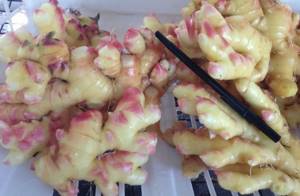
- Chinese white — this variety is characterized by the presence of a pronounced blue ring on the cut. It has a more distinct spicy aroma and pungent taste.
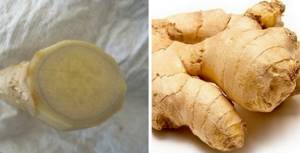
Pickled ginger: what determines the intensity of taste
Before you start pickling the ginger root, cut it into thin slices and soak in water for several hours. This removes excess bitterness and pungency of the spice. If this had not been done, it would have been impossible to put more than 1-2 pieces of the spice into the mouth. The soaking time is responsible for the intensity of the taste. A marinade made from vinegar, salt, sugar and food coloring gives pickled ginger its special taste.
Did you know? Ginger is one of the first plants brought to America.
Caring for red ginger at home
Before growing red ginger at home, you need to become familiar with its needs and, if possible, create a comfortable environment for it.
Required lighting
It is recommended to place a pot of ginger on windows on the south or southeast side. In this case, the flower should be hidden from direct sunlight. If this is not possible, you must try to provide the crop with light from artificial sources. Fluorescent lamps are suitable for this. Their range is adapted for plant cultivation.
Optimal humidity level
Like all natives of the tropics, ginger requires high air humidity. Because of this, it should be regularly sprayed with settled water.
To raise the humidity level, you can place small containers of water next to the pot.
Temperature
The temperature in the room where the pot of ginger is located should be +23…+25 °C. When it decreases, the plant will slow down and enter a dormant period.
In summer, it is better to take the plant out onto the balcony. The coolness of the night and a lot of fresh air will only benefit the flower.
Watering and loosening
Ginger requires timely and moderate watering, and it is important not to provoke rotting. The culture responds well to spraying with water at room temperature. It is better to carry out the procedure in the morning after the top layer of soil has dried.
After each watering, the surface of the substrate must be loosened with special care, since the roots are located at a depth of 2 cm.
Attention! Ignoring loosening will lead to oxygen starvation, which will negatively affect plant growth.
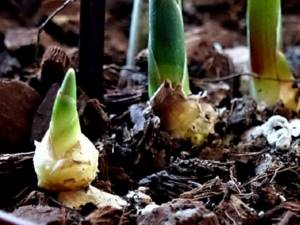
Feeding rules
Feeding and fertilizers
At the stage of early development, this crop needs nutrients in the form of organic and mineral fertilizers. Immediately after emergence, it is important to focus on fertilizers with a high nitrogen content, applying them until the plant develops sufficient green mass.
Combination with other foods
One of the most common combinations for this spice is ginger plus citrus fruits (lemon, orange). The fruits in this combination can be either fresh or candied, and honey can also be added. In Southeast Asia, a national jam is prepared from these ingredients, it is called chow-chow. But the Chinese use candied ginger without flavoring.
Tea brewed from the white root, with the addition of honey and lemon, is an excellent remedy for colds.
Due to the fact that this spice is especially useful in dishes that are difficult for the body to digest, it is indispensable where there are potatoes or legumes, such as beans. Also goes great with vegetables and rice.
